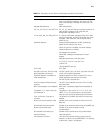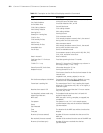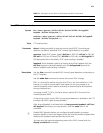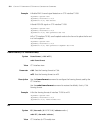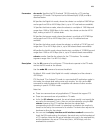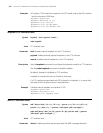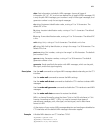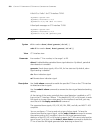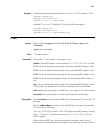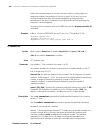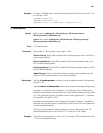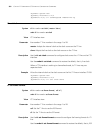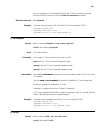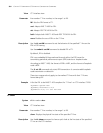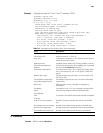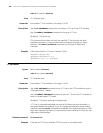
279
Example # Enable periodical alarm signal detection on T1 line 1 on CT3 interface T3 2/0.
<Sysname> system-view
[Sysname] interface t3 2/0
[Sysname-T3 2/0] t1 1 alarm detect
# Enable T1 line 1 on CT3 interface T3 2/0 to send AIS alarm signals.
<Sysname> system-view
[Sysname] interface t3 2/0
[Sysname-T3 2/0] t1 1 alarm generate ais
t1 bert
Syntax t1 line-number bert pattern { 2^11 | 2^15 | 2^20 | 2^23 | qrss } time number
[ unframed ]
undo t1 line-number bert
View CT3 interface view
Parameter line-number: T1 line number, in the range 1 to 28.
pattern: Sets a BERT pattern, which could be 2^11, 2^15, 2^20, 2^23, or QRSS.
2^11: Two to the eleventh power, length of the transmitted BERT pattern in bits.
2^15: Two to the fifteenth power, length of the transmitted BERT pattern in bits.
2^20: Two to the twentieth power, length of the transmitted BERT pattern in bits.
2^23: Two to the twenty third power, length of the transmitted BERT pattern in
bits.
qrss: Two to the twentieth power, length of the transmitted BERT pattern in bits.
In this pattern, the presence of 14 or more consecutive zeros is not allowed.
time number: Sets the duration of a BERT test, in the range of 1 to 1440 minutes.
unframed: Sets the test pattern to cover the overhead bits of the frame.
Description Use the
t1 bert command to start a BERT test on the specified T1 line on the CT3
interface.
Use the
undo t1 bert command to stop the BERT test running on the specified
T1 line on the CT3 interface.
ITU O.151, ITU O.153, and ANSI T1.403-1999 define many BERT patterns, among
which, T1 lines on CT3 interfaces support only 2^11, 2^15, 2^20, 2^23, and
QRSS at present.
When running a BERT test, the local end sends out a pattern, which is to be
looped over somewhere on the line and back to the local end. The local end then



